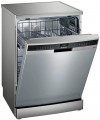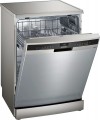Water consumption per cycle
The amount of water used by the machine in one wash cycle. Usually, it is indicated for a standard (universal) programme — at full load, without pre-rinsing, etc. Accordingly, in special modes, the consumption may differ from the indicated one.
The lower the consumption, the better. On the other hand, a reduction in consumption can harm the quality of the wash. So, when choosing an
cost-effective machine, you should pay special attention to the wash class (see below). In addition, only models of the same capacity can be compared in terms of consumption — after all, the more dishes, the more water is required to wash them.
Key programmes
—
Custom programme. Ability to create and save a custom programme by setting the parameters to your liking. This function is convenient because instead of setting the washing settings manually each time, it is enough to save them once in the device’s memory and then select a user programme from the list.
—
Half load. A special programme for those cases when the dishwasher is loaded with only half its regular capacity. Running a full-fledged wash in such cases would be too wasteful. In the half load mode, the dishwasher reduces the consumption of water, detergents and electricity and focuses on a reduced amount of dishes. Such a programme is relevant mainly for big models (from 8 place settings).
—
Pre-rinse. it is a programme where the dishes are rinsed with cold water and, due to the high humidity in the working chamber, do not dry out for a long time, and food remains do not dry out on the plates. This programme is useful in cases where unwashed dishes need to be kept inside for a long time. For example, if you need to leave the house for a couple of days, and there is no time to wash the dishes, or if there are enough dishes for the main programme to work in several meals. In addition, it can be useful for washing heavily soiled dishes — rinsing allows you to soften and then remove dried-on dirt without using
intense washing programmes (which are not available on all models).
—
Quick wash.... The programme is designed mainly for lightly soiled dishes that do not require intense washing.
— Automatic. The peculiarity of this programme is that the machine independently monitors the process of work: special sensors evaluate the composition of the water flowing from the dishes during rinsing, and when no impurities are found in it, the work ends. The washing does not last a strictly defined time but until the dishes are clean completely. It ensures optimal resource consumption. In this case, the washing mode itself can be different: in some models, the automatic programme works only in the standard mode, in others, you can select the water temperature.
— Eco. A programme that reduces the consumption of water, detergents and electricity compared to a normal wash cycle. Usually, it is intended for dishes without heavy soiling and dried food residues, although individual models may have their features of the economy mode.
— Delicate (for glass). Special programme for washing fragile dishes, especially those made of thin glass. Washing is carried out at low temperatures and with minimal mechanical stress, which allows you to keep delicate dishes intact.
— Hygienic. A programme designed for the most effective destruction of pathogenic bacteria and viruses. Usually, it provides elevated water temperatures (about 68 ... 70 °C), which can provide a bactericidal effect. The presence of this mode is very desirable if the machine is used to wash children's dishes; it can also come in handy if someone in the family gets sick.
— Intensive. Special programme for washing heavily soiled dishes, such as pans with dried-on food residues. Usually, it provides increased pressure and elevated water temperature.
— Quiet). A programme for working at night and in other situations where excessive noise is undesirable. The level of noise produced by the dishwasher in this mode is reduced due to a decrease in water temperature, a decrease in its pressure and several other tricks (their specific set depends on the model). And the necessary washing efficiency is usually provided due to the increased operating time; when you turn on the machine at night, the duration of washing is not a serious drawback.
— Steam. Hot steam treatment of dishes can be used for two purposes. The first option is a preliminary procedure similar to pre-rinse and designed to soften dried food residues; at the same time, due to the high temperature, the steam handles the task faster and more efficiently. In addition, some machines provide the possibility of sterilizing jars and other utensils for home canning in this way. However, the energy consumption during steam processing is quite high.
In addition to the above, other types of programmes may be indicated in the characteristics of dishwashers, in particular:
— Normal. Standard programme for washing lightly soiled dishes with a full load at temperatures around 65 °C. Available in almost all modern dishwashers, but sometimes manufacturers specify its availability separately.
— Plastic utensils. Programme for washing reusable plastic dishes. Usually, it provides lower temperatures and lower intensity than the standard programme — plastic is sensitive to scratches and does not tolerate high heat. We note that not all plastic dishes, even reusable ones, are compatible with a dishwasher — this point should be clarified separately, and washing disposable dishes in principle does not make sense.
— Mixed. This category includes all programmes that combine several washing modes at once. For example, the normal mode in the compartment for cups and glasses, plus the intensive one in the lower part, where you can put a pot or frying pan. Options for such combinations may be different, depending on the model.
— Self-clean. A special programme removes all kinds of impurities from the walls of the washing chamber. In the self-clean mode, the machine heats the water as much as possible using detergents and drains it often, which allows you to get rid of moderate soiling.Hot water supply
Possibility of connection of the dishwasher to a source of hot water. With this connection, the water enters the device already heated (unlike the usual procedure, when the machine heats the water to the desired temperature) — thus saving time and energy. However, the hot water supply is quite demanding on the quality of water: in most cases, it must have a temperature of 60-65 °C and flow without pressure drops.
Note that
hot water supply is an option, not the only solution; machines with the possibility of such a connection can usually work according to the standard scheme, from a source of cold water.
Noise level
It is an approximate noise level produced by the dishwasher during operation. In modern models, this parameter can range from 38 – 39 dB (muffled human voice) to 59 – 60 dB (rather a loud conversation); more detailed decoding of what sound corresponds to a particular number of decibels can be found in special tables. Anyway, the
low noise level contributes to the comfortable use of the device. It is important if the dishwasher is to be used at night.
Noise class
It allows one to decipher the values of the noise level in decibels. It is marked, like other classes, in Latin letters, where A is the quietest class of dishwashers.

